International Round Robin Test of Thermoelectric Generator Modules
Abstract
:1. Introduction
2. Materials and Methods
2.1. TEM Metrology Survey
2.2. TEGMA—Thermoelectric Generator Measurement Apparatus
2.3. Round Robin Tests on TEM Metrology
2.3.1. Sample Information
2.3.2. Participants, Organization, and Test Program of the Round Robin Test
3. Results and Discussion
3.1. Uncertainty of TEGMA Power Measurement
3.2. Uncertainty of TEGMA Heat Flow Measurement
3.3. Uncertainty of TEGMA Efficiency Measurement
3.4. Results of the Round Robin
3.4.1. Maximum Power Output
3.4.2. Heat Flow at Maximum Efficiency Operation
3.4.3. Maximum Efficiency
4. Conclusions
Supplementary Materials
Author Contributions
Funding
Institutional Review Board Statement
Informed Consent Statement
Data Availability Statement
Acknowledgments
Conflicts of Interest
References
- Rodriguez, R.; Preindl, M.; Cotton, J.S.; Emadi, A. Review and Trends of Thermoelectric Generator Heat Recovery in Automotive Applications. IEEE Trans. Veh. Technol. 2019, 68, 5366. [Google Scholar] [CrossRef]
- Heghmanns, A.; Wilbrecht, S.; Beitelschmidt, M.; Geradts, K. Parameter Optimization and Operating Strategy of a TEG System for Railway Vehicles. J. Electron. Mater. 2016, 45, 1633. [Google Scholar] [CrossRef]
- Kristiansen, N.R.; Snyder, G.J.; Nielsen, H.K.; Rosendahl, L. Waste Heat Recovery from a Marine Waste Incinerator Using a Thermoelectric Generator. J. Electron. Mater. 2012, 41, 1024. [Google Scholar] [CrossRef] [Green Version]
- Singh, D.V.; Pedersen, E. A review of waste heat recovery technologies for maritime applications. Energy Convers. Manag. 2016, 111, 315. [Google Scholar] [CrossRef]
- Ebling, D.G.; Krumm, A.; Pfeiffelmann, B.; Gottschald, J.; Bruchmann, J.; Benim, A.C.; Adam, M.; Labs, R.; Herbertz, R.R. Development of a System for Thermoelectric Heat Recovery from Stationary Industrial Processes. J. Electron. Mater. 2016, 45, 3433. [Google Scholar] [CrossRef]
- Wang, C.; Tang, S.; Liu, X.; Su, G.H.; Tian, W.; Qiu, S. Experimental study on heat pipe thermoelectric generator for industrial high temperature waste heat recovery. Appl. Therm. Eng. 2020, 175, 115299. [Google Scholar] [CrossRef]
- Champier, D. Thermoelectric generators: A review of applications. Energy Convers. Manag. 2017, 140, 167. [Google Scholar] [CrossRef]
- Rowe, D.M. General principles and basic considerations. Chapter 1; In Thermoelectric Handbook—Macro to Nano; Rowe, D.M., Ed.; Taylor & Francis Group: Boca Raton, FL, USA, 2006; pp. 1–15. [Google Scholar] [CrossRef]
- Zabrocki, C.K.; Goupil, H.; Ouerdane, Y.; Apertet, W.; Seifert, M.E. Continuum Theory and Modeling of Thermoelectric Elements; Goupil, C., Ed.; Wiley-VCH: Berlin, Germany, 2016; pp. 84–90. [Google Scholar]
- Ioffe, A.F.; Stilbans, L.S.; Iordanishvili, E.K.; Stavitskaya, T.S.; Gelbtuch, A.; Vineyard, G. Semiconductor Thermoelements and Thermoelectric Cooling. Phys. Today 1959, 12, 42. [Google Scholar] [CrossRef]
- Kajikawa, T. Overview of Thermoelectric Power Generation Technologies in Japan, in Thermoelectrics Application Meeting of the U.S. Office of Energy Efficiency and Renewable Energy. Available online: https://www1.eere.energy.gov/vehiclesandfuels/pdfs/thermoelectrics_app_2011/tuesday/kajikawa.pdf (accessed on 17 June 2021).
- Hi-Z. Available online: https://hi-z.com/products/ (accessed on 17 June 2021).
- II-VI Marlow. Available online: https://www.marlow.com/products/power-generators/thermoelectric-generator-teg-modules (accessed on 17 June 2021).
- Kryotherm. Available online: http://kryothermtec.com/thermoelectric-modules-for-power-generation.html (accessed on 17 June 2021).
- Komatsu. Available online: https://www.kelk.co.jp/english/products/generation.html (accessed on 17 June 2021).
- Evonik. Available online: https://www.espryx.com/product/thermoelectric-generators/en/ (accessed on 17 June 2021).
- Thermonamic. Available online: http://www.thermonamic.com/products.asp?cid=384 (accessed on 17 June 2021).
- Hachiuma, H. Activities and future vision of komatsu thermo modules. In Proceedings of the 5th European Conference on Thermoelectrics, Odessa, Ukraine, 10–12 September 2007; Available online: http://ect2007.thermion-company.com/ect2007.its.org/system/files/u1/pdf/01.pdf (accessed on 17 June 2021).
- Zheng, Y.; Tan, X.J.; Wan, X.; Cheng, X.; Liu, Z.; Yan, Q. Thermal Stability and Mechanical Response of Bi2Te3-Based Materials for Thermoelectric Applications. ACS Appl. Energy Mater. 2020, 3, 2078–2089. [Google Scholar] [CrossRef]
- Lee, D.M.; Lim, C.H.; Cho, D.C.; Lee, Y.S.; Lee, C.H. Effects of annealing on the thermoelectric and microstructural properties of deformed n-type Bi2Te3-based compounds. J. Electron. Mater. 2006, 35, 360. [Google Scholar] [CrossRef]
- Zhao, L.D.; Zhang, B.-P.; Liu, W.S.; Zhang, H.L.; Li, J.-F. Effects of annealing on electrical properties of n-type Bi2Te3 fabricated by mechanical alloying and spark plasma sintering. J. Alloys Compd. 2009, 467, 91–97. [Google Scholar] [CrossRef]
- Yamashita, O.; Tomiyoshi, S. High performance n-type bismuth telluride with highly stable thermoelectric figure of merit. J. Appl. Phys. 2004, 95, 6277. [Google Scholar] [CrossRef]
- Chen, S.; Cai, K.F.; Li, F.Y.; Shirley, S.Z. The Effect of Cu Addition on the System Stability and Thermoelectric Properties of Bi2Te3. J. Electron. Mater. 2013, 43, 1966–1971. [Google Scholar] [CrossRef]
- Lognoné, Q.; Gascoin, F. Reactivity, stability and thermoelectric properties of n-Bi2Te3 doped with different copper amounts. J. Alloys Compd. 2014, 610, 1–5. [Google Scholar] [CrossRef]
- He, W.; Zhang, G.; Zhang, X.; Ji, J.; Li, G.; Zhao, X. Recent development and application of thermoelectric generator and cooler. Appl. Energy 2015, 143, 1–25. [Google Scholar] [CrossRef]
- Chen, Y.; Hou, X.; Ma, C.; Dou, Y.; Wu, W. Review of Development Status of Bi2Te3-Based Semiconductor Thermoelectric Power Generation. Adv. Mater. Sci. Eng. 2018, 2018, 1210562. [Google Scholar] [CrossRef] [Green Version]
- Salvador, J.R.; Cho, J.Y.; Ye, Z.; Moczygemba, J.E.; Thompson, A.J.; Sharp, J.W.; König, J.D.; Maloney, R.; Thompson, T.; Sakamoto, J.; et al. Thermal to Electrical Energy Conversion of Skutterudite-Based Thermoelectric Modules. J. Electron. Mater. 2013, 42, 1389. [Google Scholar] [CrossRef]
- Ochi, T.; Nie, G.; Suzuki, S.; Kikuchi, M.; Ito, S.; Guo, J.Q. Power-Generation Performance and Durability of a Skutterudite Thermoelectric Generator. J. Electron. Mater. 2014, 43, 2344. [Google Scholar] [CrossRef]
- Garcia-Canadas, J.; Powell, A.V.; Kaltzoglou, A.; Vaqueiro, P.; Min, G. Fabrication and Evaluation of a Skutterudite-Based Thermoelectric Module for High-Temperature Applications. J. Electron. Mater. 2013, 42, 1369. [Google Scholar] [CrossRef]
- Bartolomé, K.; Balke, B.; Zuckermann, D.; Köhne, M.; Müller, M.; Tarantik, K.; König, J. Thermoelectric Modules Based on Half-Heusler Materials Produced in Large Quantities. J. Electron. Mater. 2014, 43, 1775. [Google Scholar] [CrossRef]
- TEC TEG MFR. Available online: https://thermoelectric-generator.com/teg-cascade-800c-hot-side-thermoelectric-power-modules (accessed on 17 June 2021).
- Novus Energy Technologies. Available online: http://www.novusenergytechnologies.com/technologies/power_generation.html (accessed on 17 June 2021).
- Kryotherm. Available online: http://kryothermtec.com/medium-temperature-generating-modules-mars-series.html (accessed on 17 June 2021).
- Joshi, G.; Poudel, B. Efficient and Robust Thermoelectric Power Generation Device Using Hot-Pressed Metal Contacts on Nanostructured Half-Heusler Alloys. J. Electron. Mater. 2016, 45, 6047. [Google Scholar] [CrossRef]
- Zhang, Q.; Liao, J.; Tang, Y.; Gu, M.; Ming, C.; Qiu, P.; Bai, S.; Uher, C.; Chen, L. Realizing a thermoelectric conversion efficiency of 12% in bismuth telluride/skutterudite segmented modules through full-parameter optimization and energy-loss minimized integration. Energy Environ. Sci. 2017, 10, 956. [Google Scholar] [CrossRef]
- Mackey, J.; Dynys, F.; Sehirlioglu, A. Uncertainty analysis for common Seebeck and electrical resistivity measurement systems. Rev. Sci. Instrum. 2014, 85, 085119. [Google Scholar] [CrossRef] [PubMed]
- Lenz, E.; Edler, F.; Ziolkowski, P. Traceable Thermoelectric Measurements of Seebeck Coefficients in the Temperature Range from 300 K to 900 K. Int. J. Thermophys. 2013, 34, 1975–1981. [Google Scholar] [CrossRef]
- Jacquot, A.; Pernau, H.-F.; König, J.; Nussel, U.; Bartel, M.; Ebling, D.; Jägle, M. Measurement uncertainties in thermoelectric materials. In Proceedings of the 8th European Conference on Thermoelectrics, Como, Italy, 22 September 2010; Available online: http://docs.google.com/folder/d/0Bzub7mUI8XF3NjcyNWFiM2MtODQzMC00YmZhLWJlMTMtYTcwM2QxMjBhZjQx/edit?num=50&sort=name&layout=grid&pli=1 (accessed on 17 June 2021).
- Miers, C.; Marconnet, A. Uncertainty quantification for a high temperature Z-meter characterization system. In Proceedings of the 17th IEEE Intersociety Conference on Thermal and Thermomechanical Phenomena in Electronic Systems (ITherm), San Diego, CA, USA, 29 May–1 June 2018; pp. 572–581. [Google Scholar] [CrossRef]
- Ziolkowski, P.; Stiewe, C.; de Boor, J.; Druschke, I.; Zabrocki, K.; Edler, F.; Haupt, S.; König, J.; Müller, E. Iron Disilicide as High-Temperature Reference Material for Traceable Measurements of Seebeck Coefficient Between 300 K and 800 K. J. Electron. Mater. 2017, 46, 51. [Google Scholar] [CrossRef]
- Lowhorn, N.; Wong-Ng, W.; Lu, Z.; Martin, J.; Green, M.; Bonevich, J.; Thomas, E.; Dilley, N.; Sharp, J. Development of a Seebeck coefficient Standard Reference Material. J. Mater. Res. 2011, 26, 1983. [Google Scholar] [CrossRef]
- Borup, K.A.; de Boor, J.; Wang, H.; Drymiotis, F.; Gascoin, F.; Shi, X.; Chen, L.; Fedorov, M.I.; Müller, E.; Iversen, B.B.; et al. Measuring thermoelectric transport properties of materials. Energy Environ. Sci. 2015, 8, 423. [Google Scholar] [CrossRef] [Green Version]
- Martin, J.; Tritt, T.; Uher, C. High temperature Seebeck coefficient metrology. J. Appl. Phys. 2010, 108, 121101. [Google Scholar] [CrossRef]
- Wang, H.; Porter, W.D.; Böttner, H.; König, J.; Chen, L.; Bai, S.; Tritt, T.M.; Mayolet, A.; Senawiratne, J.; Smith, C.; et al. Transport Properties of Bulk Thermoelectrics—An International Round-Robin Study, Part I: Seebeck Coefficient and Electrical Resistivity. J. Electron. Mater. 2013, 42, 654. [Google Scholar] [CrossRef]
- Wang, H.; Bai, S.; Chen, L.; Cuenat, A.; Joshi, G.; Kleinke, H.; König, J.; Lee, H.W.; Martin, J.; Oh, M.-W.; et al. International Round-Robin Study of the Thermoelectric Transport Properties of an n-Type Half-Heusler Compound from 300 K to 773 K. J. Electron. Mater. 2015, 44, 4482. [Google Scholar] [CrossRef]
- Lowhorn, N.D.; Wong-Ng, W.; Zhang, W.; Lu, Z.Q.; Otani, M.; Thomas, E.; Green, M.; Tran, T.N.; Dilley, N.; Ghamaty, S.; et al. Round-robin measurements of two candidate materials for a Seebeck coefficient Standard Reference Material. Appl. Phys. A 2009, 94, 231. [Google Scholar] [CrossRef]
- Alleno, E.; Bérardan, D.; Byl, C.; Candolfi, C.; Daou, R.; Decourt, R.; Guilmeau, E.; Hébert, S.; Hejtmanek, J.; Lenoir, B.; et al. A round robin test of the uncertainty on the measurement of the thermoelectric dimensionless figure of merit of Co0.97Ni0.03Sb3. Rev. Sci. Instrum. 2015, 86, 011301. [Google Scholar] [CrossRef] [PubMed]
- Chetty, R.; Nagase, K.; Aihara, M.; Jood, P.; Takazawa, H.; Ohta, M.; Yamamoto, A. Mechanically durable thermoelectric power generation module made of Ni-based alloy as a reference for reliable testing. Appl. Energy 2020, 260, 114443. [Google Scholar] [CrossRef]
- Ziolkowski, P.; Chetty, R.; Blaschkewitz, P.; Ohta, M.; Yamamoto, A.; Müller, E. Inter-Laboratory Testing for High Temperature Power Generation Characteristics of a Ni-Based Alloy Thermoelectric Module. Energy Technol. 2020, 8, 2000557. [Google Scholar] [CrossRef]
- BIPM; IEC; IFCC; ILAC; ISO; IUPAC; IUPAP; OIML. Guide to the Expression of Uncertainties in Measurement. Joint Committee for Guides in Metrology 100:2008, GUM 1995 with Minor Corrections. Available online: https://www.bipm.org/documents/20126/2071204/JCGM_100_2008_E.pdf/cb0ef43f-baa5-11cf-3f85-4dcd86f77bd6 (accessed on 17 June 2021).
- Ziolkowski, P.; Blaschkewitz, P.; Müller, E. Heat Flow Measurement as a key to Standardization of Thermoelectric Generator Module Metrology: A Comparison of reference and absolute Techniques. Measurement 2021, 167, 108273. [Google Scholar] [CrossRef]
- Ziolkowski, P.; Blaschkewitz, P.; Müller, E. Validation of commercial Bi2Te3-based thermoelectric generator modules for application as metrological reference samples. Measurement 2021, 177, 109247. [Google Scholar] [CrossRef]
- Marchi, A.D.; Giaretto, V. An accurate new method to measure the dimensionless figure of merit of thermoelectric devices based on the complex impedance porcupine diagram. Rev. Sci. Instrum. 2011, 82, 104904. [Google Scholar] [CrossRef] [Green Version]
- Iwasaki, H.; Yokoyama, S.; Tsukui, T.; Koyano, M.; Hori, H.; Sano, S. Evaluation of the Figure of Merit of Thermoelectric Modules by Harman Method. Jpn. J. Appl. Phys. 2003, 42, 3707. [Google Scholar] [CrossRef]
- Wang, H.; McCarty, R.; Salvador, J.R.; Yamamoto, A.; König, J. Determination of thermoelectric module efficiency: A survey. J. Electron. Mater. 2014, 43, 2274. [Google Scholar] [CrossRef]
- Min, G.; Rowe, D.M.; Kontostavlakis, K. Thermoelectric figure-of-merit under large temperature differences. J. Phys. D Appl. Phys. 2004, 37, 1301–1304. [Google Scholar] [CrossRef]
- Zabrocki, K. Continuum theory of TE elements. In Continuum Theory and Modeling of Thermoelectric Elements; Goupil, C., Ed.; Wiley-VCH: Berlin, Germany, 2016; pp. 1–74. ISBN 9783527413379. [Google Scholar]
- Ryu, B.; Chung, J.; Park, S. Thermoelectric degrees of freedom determining thermoelectric efficiency. Iscience 2021, 24, 102934. [Google Scholar] [CrossRef] [PubMed]
- Armstrong, H.; Boese, M.; Carmichael, C.; Dimich, H.; Seay, D.; Sheppard, N.; Beekman, M. Estimating Energy Conversion Efficiency of Thermoelectric Materials: Constant Property Versus Average Property Models. J. Electron. Mater. 2017, 46, 6. [Google Scholar] [CrossRef]
- Kim, H.S.; Liu, W.; Chen, G.; Chu, C.-W.; Ren, Z. Relationship between thermoelectric figure of merit and energy conversion efficiency. Proc. Natl. Acad. Sci. USA 2015, 112, 8205. [Google Scholar] [CrossRef] [PubMed] [Green Version]
- Groß, E.; Riffel, M.; Stöhrer, U. Thermoelectric generators made of FeSi2 and HMS: Fabrication and measurement. J. Mater. Res. 1995, 10, 34–40. [Google Scholar]
- Müller, E.; Bruch, J.U.; Schilz, J. TE generator test facility for low resistance single elements. In Proceedings of the International Conference on Thermoelectrics, Nagoya, Japan, 24–28 May 1998; pp. 441–444. [Google Scholar]
- Takazawa, H.; Obara, H.; Okada, Y.; Kobayashi, K.; Onishi, T.; Kajikawa, T. Efficiency measurement of thermoelectric modules operating in the temperature difference of up to 550 K. In Proceedings of the 25th International Conference on Thermoelectrics, Vienna, Austria, 6–10 August 2006; pp. 189–192. [Google Scholar] [CrossRef]
- ASTM E1225-13. Standard Test Method for Thermal Conductivity of Solids Using the Guarded-Comparative-Longitudinal Heat Flow Technique; ASTM International: West Conshohocken, PA, USA, 2020. [Google Scholar]
- Tye, R.P. The measurement of thermal conductivity by the comparative method. In Compendium of Thermophysical Property Measurement Methods: Volume 2 Recommended Measurement Techniques and Practices; Maglić, K.D., Cezairliyan, A., Peletsky, V.E., Eds.; Springer: Boston, MA, USA, 1992; pp. 77–97. [Google Scholar]
- Chiba, H.; Ogushi, T.; Nakajima, H.; Torii, K.; Tomimura, T.; Ono, F. Steady state comparative-longitudinal heat flow method using specimen of different thicknesses for measuring thermal conductivity of lotus-type porous metals. J. Appl. Phys. 2008, 103, 013515. [Google Scholar] [CrossRef]
- Zhao, D.; Qian, X.; Gu, X.; Jajja, S.A.; Yang, R. Measurement Techniques for Thermal Conductivity and Interfacial Thermal Conductance of Bulk and Thin Film Materials. J. Electron. Packag. 2016, 138, 040802. [Google Scholar] [CrossRef] [Green Version]
- Eivari, H.A.; Sohbatzadeh, Z.; Mele, P.; Assadi, M.H.N. Low thermal conductivity: Fundamentals and theoretical aspects in thermoelectric applications. Mater. Today Energy 2021, 21, 100744. [Google Scholar] [CrossRef]
- National Physical Laboratory. Available online: https://www.npl.co.uk/products-services/advanced-materials/thermal-conductivity (accessed on 17 June 2021).
- Populoh, S.; Trottmann, M.; Brunko, O.C.; Thiel, P.; Weidenkaff, A. Construction of a high temperature TEG measurement System for the evaluation of thermoelectric oxide modules. Funct. Mater. Lett. 2013, 6, 1340012. [Google Scholar] [CrossRef]
- Hejtmanek, J.; Knizek, K.; Svejda, V.; Horna, P.; Sikora, M. Test System for Thermoelectric Modules and Materials. J. Electron. Mater. 2014, 43, 3726–3732. [Google Scholar] [CrossRef]
- Koenig, J.D.; Nussel, U.; Bartel, M.; Vetter, U. Complete Thermoelectric Generator Performance Measurement. MRS Online Proc. Libr. 2009, 1218, 410. [Google Scholar] [CrossRef]
- Man, E.A.; Schaltz, E.; Rosendahl, L.; Rezaniakolaei, A.; Platzek, D. A High Temperature Experimental Characterization Procedure for Oxide-Based Thermoelectric Generator Modules under Transient Conditions. Energies 2015, 8, 12839–12847. [Google Scholar] [CrossRef] [Green Version]
- Chien, H.C.; Chu, E.T.; Hsieh, H.L.; Huang, J.Y.; Wu, S.T.; Dai, M.J.; Liu, C.K.; Yao, D.J. Evaluation of Temperature-Dependent Effective Material Properties and Performance of a Thermoelectric Module. J. Electron. Mater. 2013, 42, 2362–2370. [Google Scholar] [CrossRef]
- National Institute of Standards and Technology. Available online: https://www-s.nist.gov/srmors/view_detail.cfm?srm=8420 (accessed on 22 June 2021).
- Short, J.; D’Angelo, J.; Downey, A.; Pajor, M.; Timm, E.; Schock, H.; Kanatzidis, M.; Hogan, T. Characterization of Thermoelectric Power Generation Modules Made from New Materials. MRS Proc. 2005, 886, 0886-F08-09. [Google Scholar] [CrossRef] [Green Version]
- Sweet, J.N.; Roth, E.P.; Moss, M. Thermal conductivity of Inconel 718 and 304 stainless steel. Int. J. Thermophys. 1987, 8, 593–606. [Google Scholar] [CrossRef]
- Lide, D.R. Handbook of Chemistry and Physics, 79th ed.; CRC Press LLC: New York, NY, USA, 1998; pp. 12–193. [Google Scholar]
- Sugawara, A. The Precise Determination of thermal conductivity of fused quartz. J. Appl. Phys. 1968, 39, 5994–5997. [Google Scholar] [CrossRef]
- ISO 8302:1991. Thermal Insulation—Determination of Steady-State Thermal Resistance and Related Properties—Guarded Hot Plate Apparatus; International Organization for Standardization: Geneva, Switzerland, 1991. [Google Scholar]
- ASTM C177-19. Standard Test Method for Steady-State Heat Flux Measurements and Thermal Transmission Properties by Means of the Guarded-Hot-Plate Apparatus; ASTM International: West Conshohocken, PA, USA, 2019. [Google Scholar] [CrossRef]
- Woodside, W. Analysis of errors due to edge heat loss in guarded hot plates. In Symposium on Thermal Conductivity Measurements and Applications of Thermal Insulations; ASTM International: West Conshohocken, PA, USA, 1957; pp. 49–64. [Google Scholar] [CrossRef] [Green Version]
- Pratt, A.W. Analysis of error due to edge heat loss in measuring thermal conductivity by the hot plate method. J. Sci. Instrum. 1962, 39, 63–68. [Google Scholar] [CrossRef]
- Hemminger, W.; Jugel, R. A guarded hot-plate apparatus for thermal conductivity measurements over the temperature range −75 to 200 °C. Int. J. Thermophys. 1985, 6, 483–498. [Google Scholar] [CrossRef]
- Hammerschmidt, U. Guarded Hot-Plate (GHP) Method: Uncertainty Assessment. Int. J. Thermophys. 2002, 23, 1551–1570. [Google Scholar] [CrossRef]
- Flynn, D.R.; Zarr, R.R.; Hahn, M.H.; Healy, W.M. Design concepts for a new guarded hot plate apparatus for use over an extended temperature range. In Insulation Materials: Testing and Applications: 4th Volume, ASTM STP 1426; Desjarlais, A.O., Zarr, R.R., Eds.; ASTM International: West Conshohocken, PA, USA, 2002. [Google Scholar]
- Yao, K.; Zheng, H.; Liu, Y.; Meng, X.; Zhou, Y.; Wang, X.; Wang, K.; Wang, Q. Calibration Method and Uncertainty Assessment of a High-Temperature GHP Apparatus. Int. J. Thermophys. 2018, 39, 1–17. [Google Scholar] [CrossRef]
- GHP 456-Titan. Website of the Manufacturer Netzsch Gerätebau GmbH. Available online: https://www.netzsch-thermal-analysis.com/en/products-solutions/thermal-conductivity/ghp-456-titan/ (accessed on 21 June 2021).
- Thermal Conductivity Test Tool λ-Meter EP500e. Website of the Manufacturer Lambda-Meßtechnik GmbH. Available online: https://www.lambda-messtechnik.de/en/thermal-conductivity-test-tool-ep500e/lambda-meter-ep500-characteristics (accessed on 21 June 2021).
- Fox 600 GHP. Website of the Manufacturer TA Instruments. Available online: https://www.tainstruments.com/ghp-600/ (accessed on 21 June 2021).
- Liao, M.; He, Z.; Jiang, C.; Fan, X.; Li, Y.; Qi, F. A three-dimensional model for thermoelectric generator and the influence of Peltier effect on the performance and heat transfer. Appl. Therm. Eng. 2018, 133, 493–500. [Google Scholar] [CrossRef]
- Montecucco, A.; Buckle, J.; Siviter, J.; Knox, A.R. A New Test Rig for Accurate Nonparametric Measurement and Characterization of Thermoelectric Generators. J. Electron. Mater. 2013, 42, 1966–1973. [Google Scholar] [CrossRef]
- Sandoz-Rosado, E.; Stevens, R.J. Experimental Characterization of Thermoelectric Modules and Comparison with Theoretical Models for Power Generation. J. Electron. Mater. 2009, 38, 1239–1244. [Google Scholar] [CrossRef]
- Zybala, R.; Schmidt, M.; Kaszyca, L.; Ciupinski, L.; Kruszewski, J.; Pietrzak, K. Method and Apparatus for Determining Operational Parameters of Thermoelectric Modules. J. Electron. Mater. 2016, 45, 5223–5231. [Google Scholar] [CrossRef] [Green Version]
- Hu, X.; Nagase, K.; Jood, P.; Ohta, M.; Yamamoto, A. Power Generation Evaluated on a Bismuth Telluride Unicouple Module. J. Electron. Mater. 2015, 44, 1785–1790. [Google Scholar] [CrossRef]
- Anatychuk, L.I.; Havrylyuk, M.V. Procedure and Equipment for Measuring Parameters of Thermoelectric Generator Modules. J. Electron. Mater. 2011, 40, 1292–1297. [Google Scholar] [CrossRef]
- Kwon, S.; Kim, Y.-G.; Lee, S.; Kim, J.C. Measurement of the figure-of-merit of thermoelectric devices. In Proceedings of the XX IMEKO World Congress Metrology for Green Growth, Busan, Korea, 9–14 September 2012; Available online: https://www.imeko.org/publications/wc-2012/IMEKO-WC-2012-SS1-O2.pdf (accessed on 23 June 2021).
- Rauscher, L.; Kaibe, H.T.; Ishimabushi, H.; Sano, S.; Muller, E.W.; Platzek, D. New approach for highly accurate efficiency determination of thermoelectric generator modules. In Proceedings of the ICT 2003, 22nd International Conference on Thermoelectrics, La Grande Motte, France, 17–21 August 2003; pp. 508–511, IEEE Cat. No.03TH8726. [Google Scholar] [CrossRef]
- Rauscher, L.; Fujimoto, S.; Kaibe, H.T.; Sano, S. Efficiency determination and general characterization of thermoelectric generators using an absolute measurement of the heat flow. Meas. Sci. Technol. 2005, 16, 1054. [Google Scholar] [CrossRef]
- Anatychuck, L.I.; Kuz, R.V. Materials for Vehicular Thermoelectric Generators. J. Electron. Mater. 2012, 41, 1778–1784. [Google Scholar] [CrossRef]
- Clark, J.; Tye, R. Thermophysical properties reference data for some key engineering alloys. High Temp.-High Press. 2003, 35, 1–14. [Google Scholar] [CrossRef]
- Weisstein, E.W. Gaussian Function From MathWorld-A Wolfram Web Resource. Available online: https://mathworld.wolfram.com/GaussianFunction.html (accessed on 16 February 2022).
- Hässelbarth, W. BAM-Leitfaden zur Ermittlung von Messunsicherheiten bei Quantitativen Prüfergebnissen—1. Fassung März 2004; Wirtschaftsverlag NW: Bremerhaven, Germany, 2004; pp. 1–52. Available online: http://d-nb.info/991763459 (accessed on 17 June 2021).
- Isabellenhütte PBV Product Brochure. Available online: https://www.isabellenhuette.de/fileadmin/Daten/Praezisionswiderstaende/IHH_Bauelementebroschuere_dt.pdf (accessed on 6 July 2021).
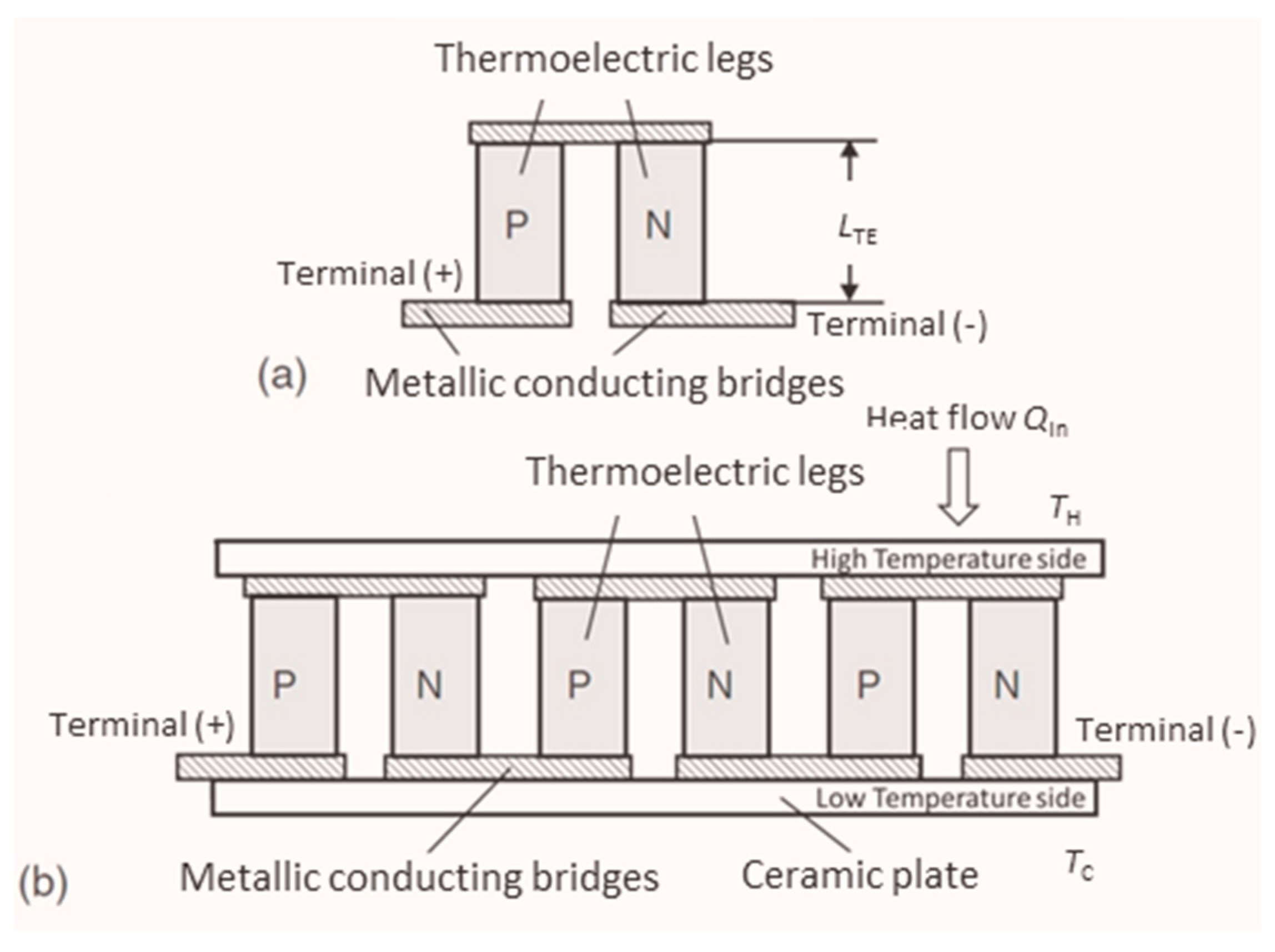

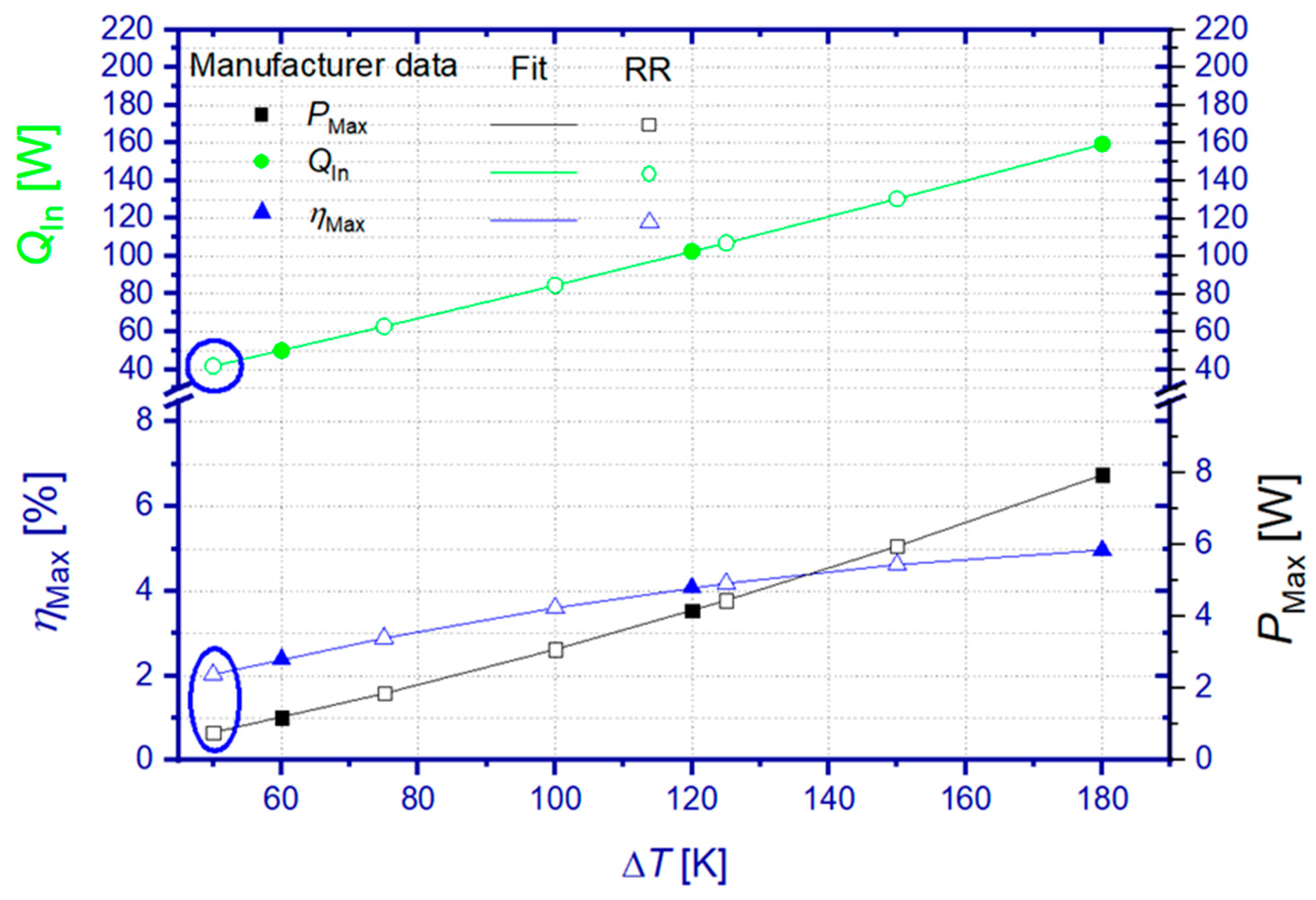

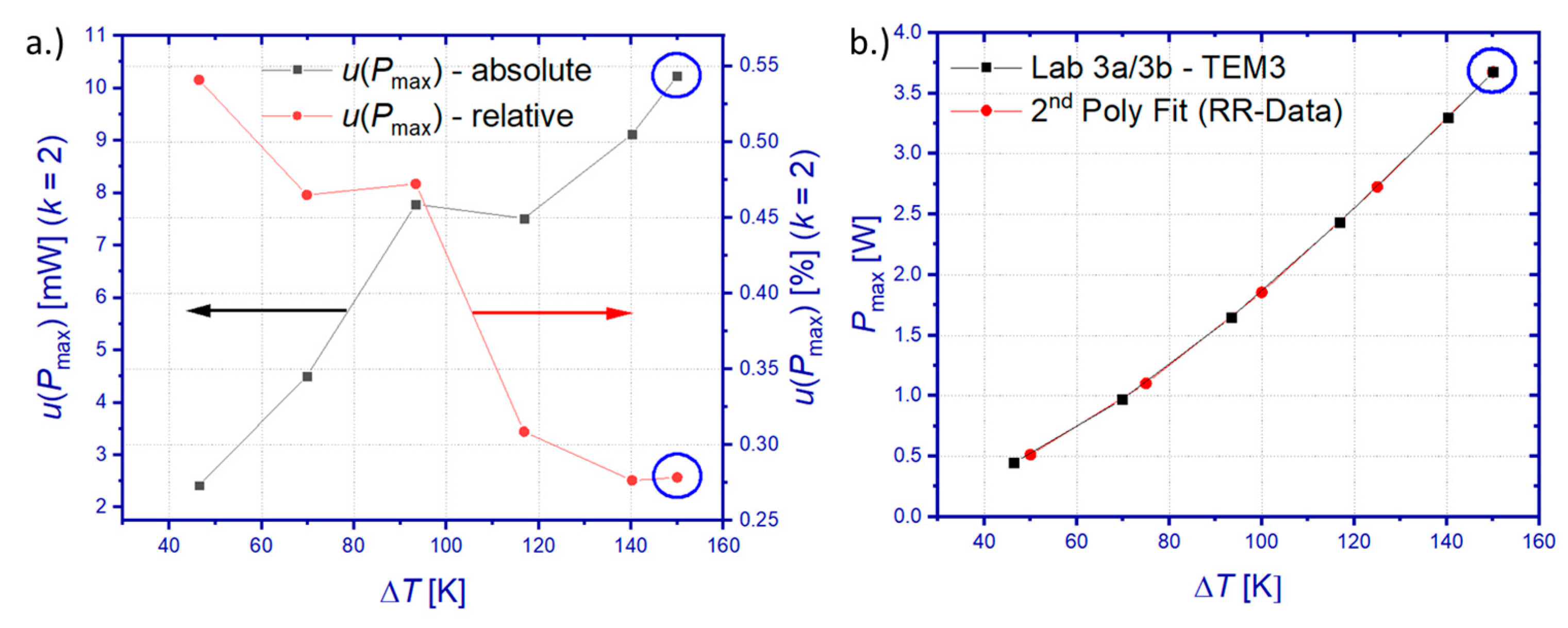




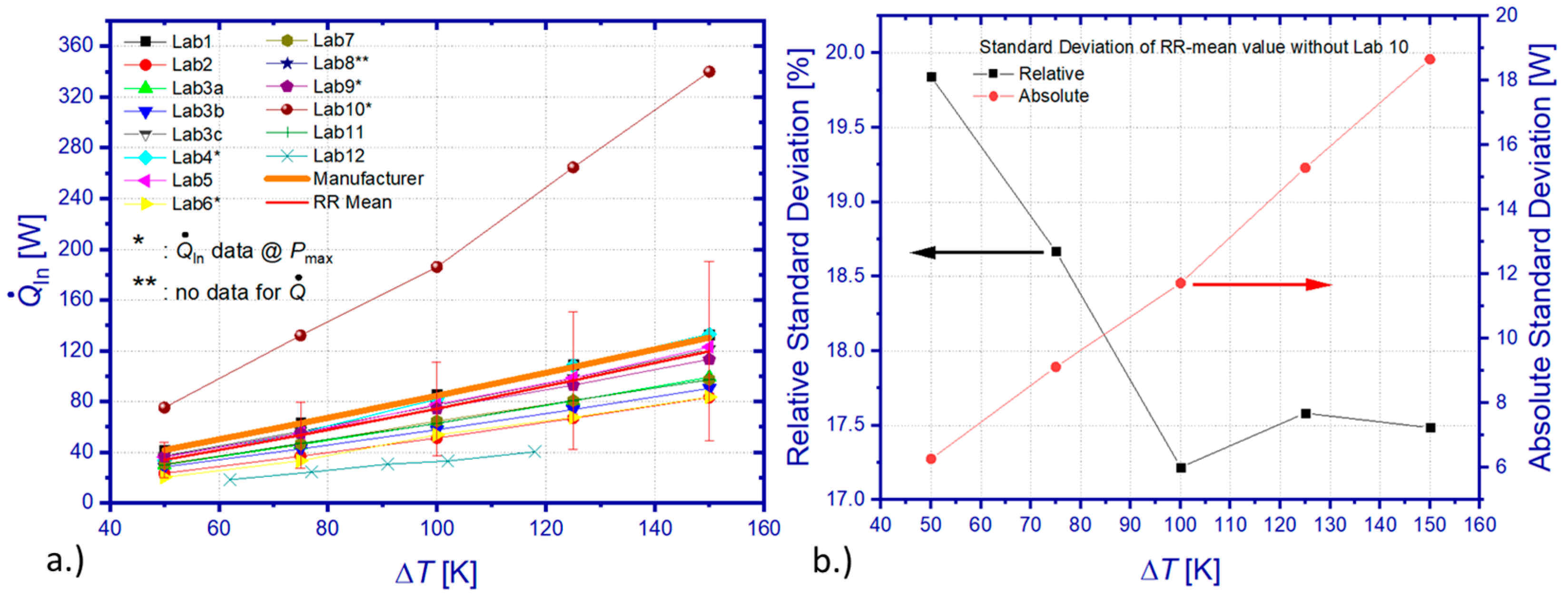
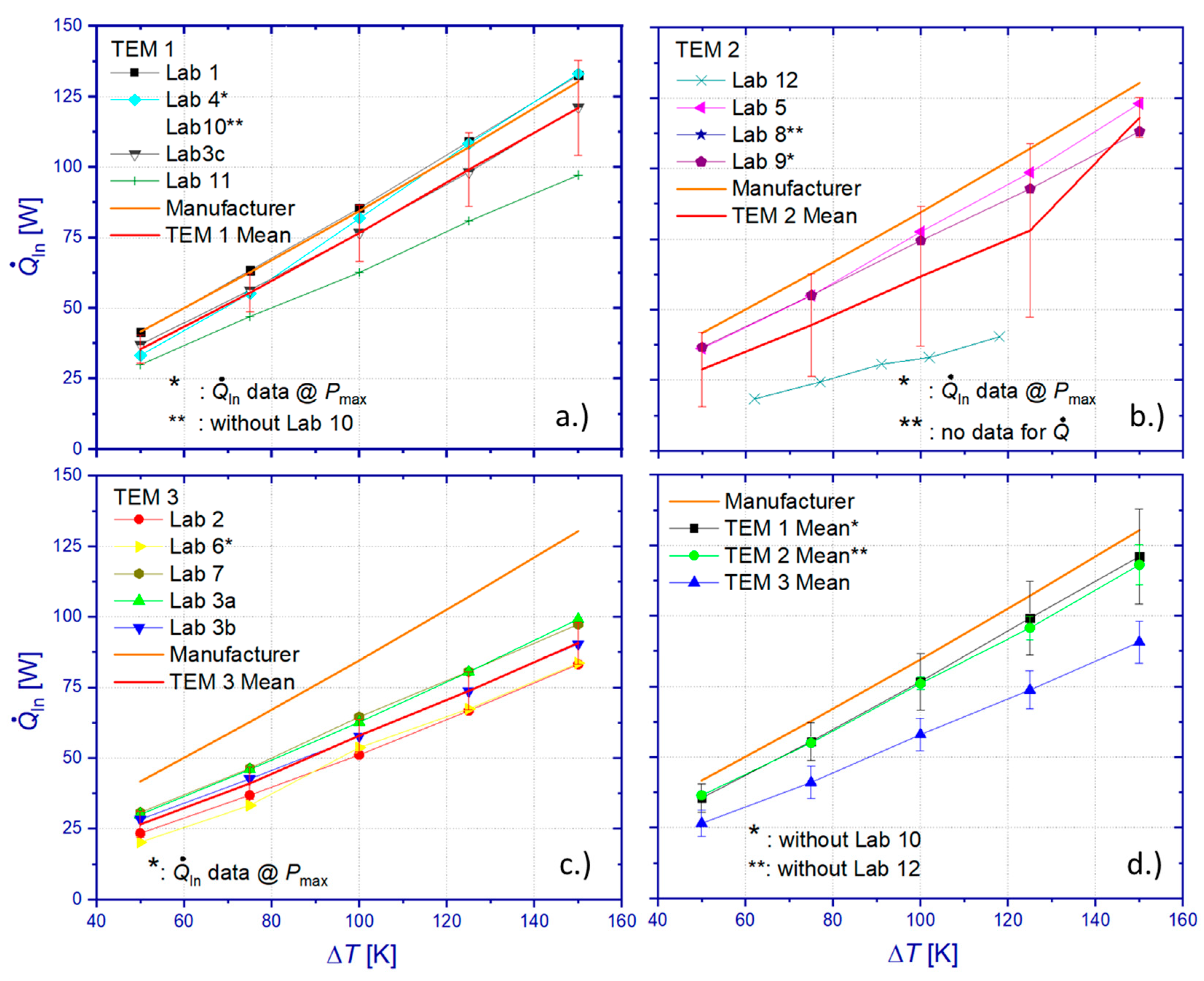

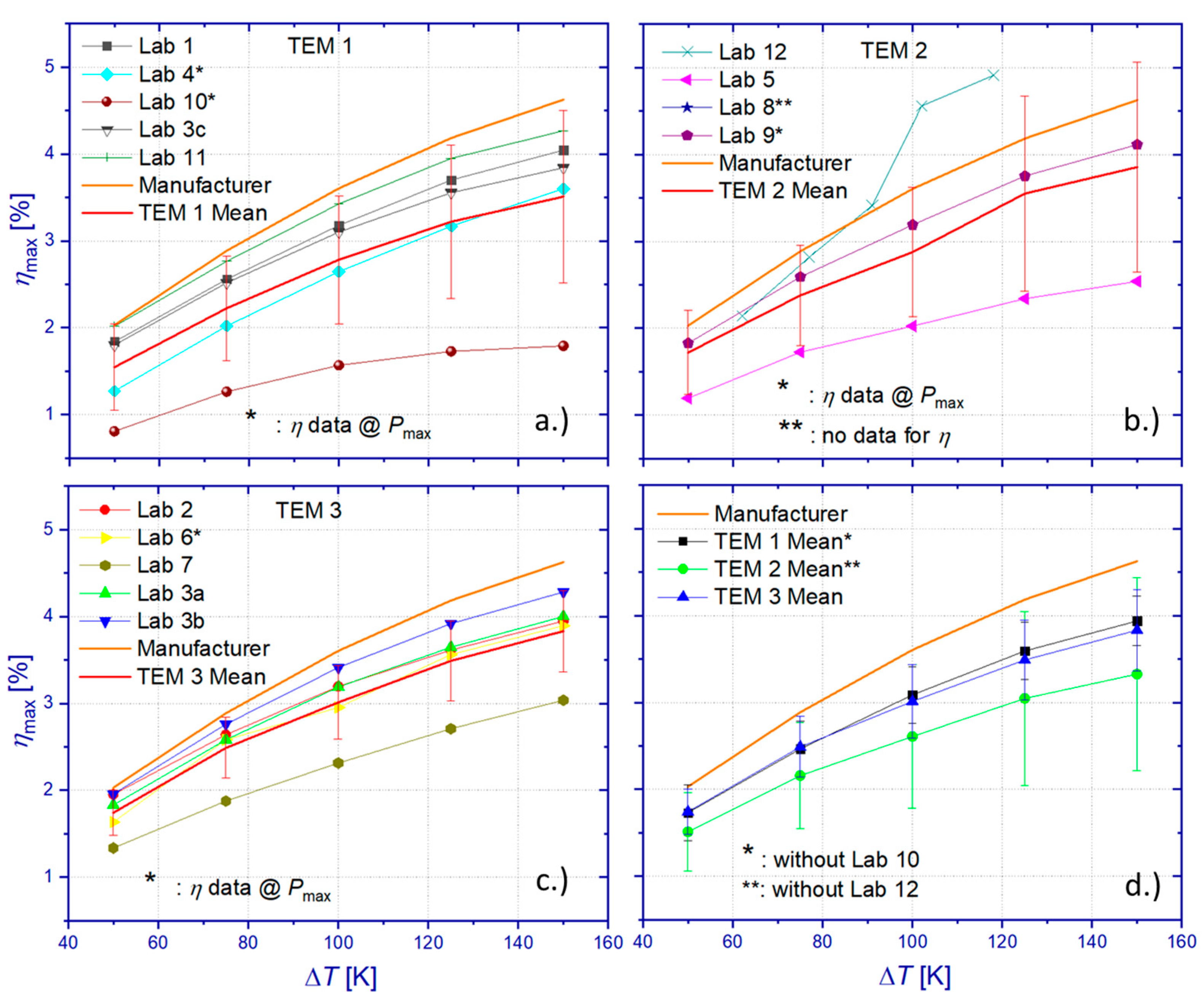
| Place of Origin | Geometry [mm3] | Max. TH [°C] | Nominal TH/TC [°C] | Ri [Ω] | Pmax [W] | ηmax [%] |
|---|---|---|---|---|---|---|
| USA | 40 × 40 × 3.5 | 230 | 230/50 | 3.46 | 7.95 | 4.97 |
| TEM 1 | TEM 2 | TEM 3 |
|---|---|---|
| Lab 1 | Lab 12 | Lab 2 |
| Lab 4 | Lab 5 | Lab 6 |
| Lab 10 | Lab 8 | Lab 7 |
| Lab 3c | Lab 9 | Lab 3a/3b |
| Lab 11 | -/- | -/- |
| ΔT [K] | 50 | 75 | 100 | 125 | 150 |
| u(P)avg [mW] | 5.27 | 9.72 | 14.07 | 18.21 | 24.26 |
| u(P)avg [%] | 2.33 | 2.02 | 1.63 | 1.21 | 1.25 |
Publisher’s Note: MDPI stays neutral with regard to jurisdictional claims in published maps and institutional affiliations. |
© 2022 by the authors. Licensee MDPI, Basel, Switzerland. This article is an open access article distributed under the terms and conditions of the Creative Commons Attribution (CC BY) license (https://creativecommons.org/licenses/by/4.0/).
Share and Cite
Ziolkowski, P.; Blaschkewitz, P.; Ryu, B.; Park, S.; Müller, E. International Round Robin Test of Thermoelectric Generator Modules. Materials 2022, 15, 1627. https://doi.org/10.3390/ma15051627
Ziolkowski P, Blaschkewitz P, Ryu B, Park S, Müller E. International Round Robin Test of Thermoelectric Generator Modules. Materials. 2022; 15(5):1627. https://doi.org/10.3390/ma15051627
Chicago/Turabian StyleZiolkowski, Pawel, Przemyslaw Blaschkewitz, Byungki Ryu, SuDong Park, and Eckhard Müller. 2022. "International Round Robin Test of Thermoelectric Generator Modules" Materials 15, no. 5: 1627. https://doi.org/10.3390/ma15051627







